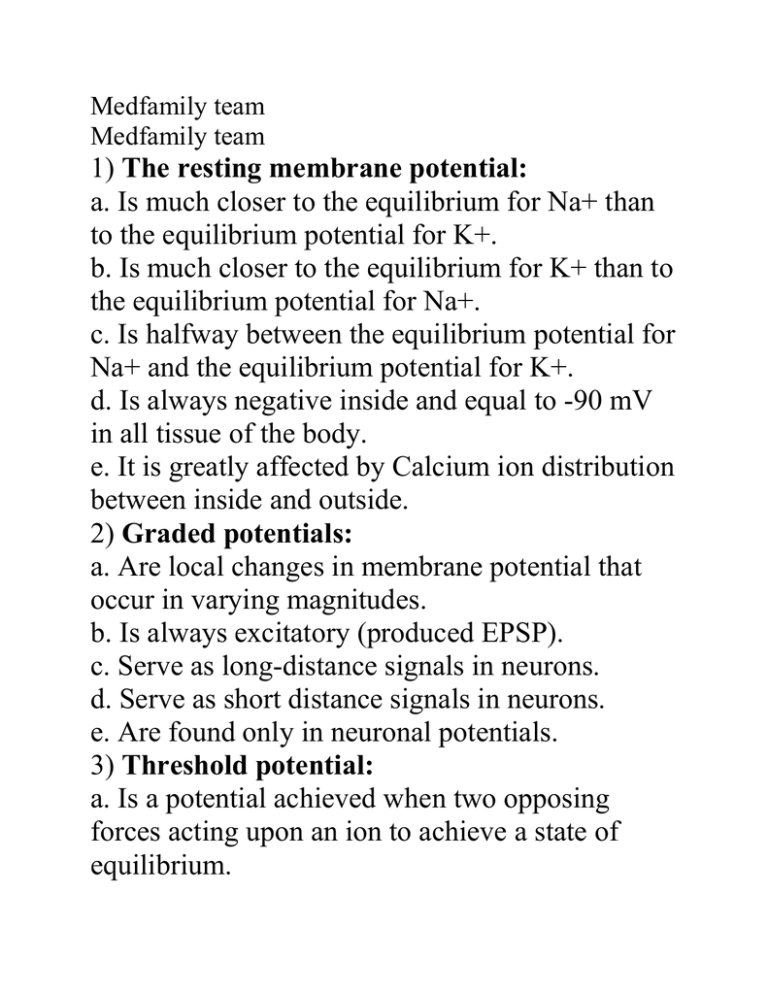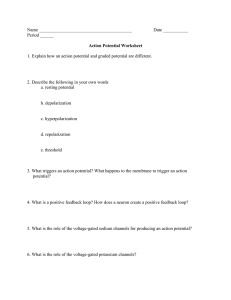1) The resting membrane potential: a. Is much closer to the
advertisement

Medfamily team Medfamily team 1) The resting membrane potential: a. Is much closer to the equilibrium for Na+ than to the equilibrium potential for K+. b. Is much closer to the equilibrium for K+ than to the equilibrium potential for Na+. c. Is halfway between the equilibrium potential for Na+ and the equilibrium potential for K+. d. Is always negative inside and equal to -90 mV in all tissue of the body. e. It is greatly affected by Calcium ion distribution between inside and outside. 2) Graded potentials: a. Are local changes in membrane potential that occur in varying magnitudes. b. Is always excitatory (produced EPSP). c. Serve as long-distance signals in neurons. d. Serve as short distance signals in neurons. e. Are found only in neuronal potentials. 3) Threshold potential: a. Is a potential achieved when two opposing forces acting upon an ion to achieve a state of equilibrium. b. Is the peak potential achieved during an action potential. c. Is the point at which there is an explosive increase in Na+ permeability. d. Is the potential at which the permeability to K+ increases. e. Is always positive in potential. 4) The membrane is more permeable to K+ than to Na+ at all of the following EXCEPT: a. At resting potential. b. During the rising phase of an action potential. c. During the falling phase of an action potential. d. During hyper-polarization. e. During an IPSP signal. 5) Salutatory conduction: a. Occurs in unmyelinated nerve fibers. b. Is slower than conduction by local current flow because of the myelin. c. Involves the impulse jumping from one node of Ranvier to the adjacent node. d. Refers to the action potential spreading from one myelin-forming cell to the adjacent myelinforming cell. e. More than one of the above are correct. 6) Which of the following statements concerning the absolute refractory period is wrong? a. It refers to the period of time during which the neuron can not be stimulated again no matter how strong the stimulus. b. It corresponds to the time period during which the Na+ gates are first opened and then closed and inactivated. c. It assure the unidirectional spread of the action potential down the nerve fiber away from the initial site of activation. d. It is longer in duration than relative refractory period. e. It is much longer for twitch muscle than it is for neuron. 7) Compound action potential recorded in a neuronal bundle is due to: a. Different threshold values for different neurons. b. Different velocities of conduction in different neurons. c. Different action potential amplitudes in different neurons. d. Different rate of stimulation in different neurons. e. Varying length of the neurons. 8) Which of the following fibers have the fastest conduction velocity: a. Autonomic C fibers. b. Autonomic B fibers. c. Alfa A fibers. d. Beta A fibers. Medfamily team Medfamily team e. Gamma A fibers. 9) Acetylecholine receptors in NM junction are competitively blocked by: a. Physostigmine. b. Military nerves gases. c. Black spider venom. d. Curare. e. Clostridium botulinum toxins. 10) Temporal summation: a. Takes place when two EPSPs from the same presynaptic input occur so closely together in time that they add together or sum. b. Takes place when an EPSP and IPSP occur simultaneously in time and cancel each other out. c. Takes place when two EPSPs that occur simultaneously from different presynaptic inputs add together or sum on the same cell body. d. Takes place when action potentials occurring in two presynaptic inputs simultaneously converge upon the postsynaptic cell. e. Occur in smooth muscle only. 11) An IPSP: a) Is produced by increased permeability to Na+ and K+. b) Is produced by increased permeability to K+ and or to Cl -. c) Is a small depolarization of the postsynaptic cell. d) Occurs only at synapses but not NM junctions. e) Both (a) and (d) above are correct. 12) All of the following differences between NM junction and synapses are correct EXCEPT: a. Spatial summation is present only in synapses. b. There is one NM junction on each muscle fibers but multiple synapses on neurons. c. Both could have either inhibitory or excitatory effects on post-junctional fibers. d. Well organized NM junctions are found only on skeletal muscle fibers. e. Myasthenia gravis occurs only in NM junction. 13) Which of the following is the neurotransmitter in all autonomic ganglia: a. Nor-adrenaline. b. Adrenaline. c. Acetylcholine d. Nicotine. e. Muscarine. 14) Which of the following are cholinergic receptors: a. Beta 1 receptors. b. Beta 2 receptors. c. Alfa 1 receptors. d. Alfa 2 receptors. e. Nicotinic receptors. 15) All the following responses are produced by sympathetic activity (during emergency ) Except: a. Increased heart rate. b. Pupil dilation. c. Broncho-constriction. d. Release of adrenaline. e. Constriction of skin blood vessels. 16) Which of the following is wrong about membrane during resting: a. Is more permeable to k+ than to Na+. b. The Na – K+ pump is inhibited. c. Has negative potential on the inside. d. Na+ can leak through the membrane to inside. Medfamily team Medfamily team e. Is close to the equilibrium potential of K+. 17) Given log 10=1, log 100=2, log 1000= 3, calculate the resting membrane potential when the concentration of K+ in ECF is 13 mM and in ICF 130 mM: a. - 80 mV. b. -62 mV. c. + 70 mV. d. +62 mV. e. – 90 mV. 18) All of the following contribute to the genesis of the resting membrane potential Except: a. The Na+ - K+ pump activity. b. The diffusion of K+ ion down it's concentration gradient. c. The diffusion of Na+ ion down it's concentration gradient. d. The selective permeability of the membrane to ions of Na+ and K+. e. The opening and closing of the Na+ voltage gated channels during resting. 19) All the following sentences about action potential are true Except: a. Is produced by the opening of Na+ and K+ voltage gated channels. b. Is produced only in cells which has negative resting membrane potential. c. In the neurons it is normally generated at the cell body. d. Is graded response. e. Its fast upstroke is produced by influx of Na+ 20) Salutatory conduction: a. Describes fast conduction of action potential in mylinated neuron. b. Involves the action potential jumping from one node of ranvier to the next. c. Consumes large quantity of ATP. d. Refers to action potential spreading from one schwan cell to another. e. A and B are correct. 21) During depolarization stage of the action potential: a. There is net outward current and the cell interior becomes more negative. b. There is net outward current and the cell interior becomes less negative. c. There is net inward current and the cell interior becomes more negative. d. There is net inward current and the cell interior becomes less negative. 22) The conduction velocity of the nerve fibers is increased by: a. Decreased temperature. b. Increased concentration of the external sodium ions. c. Increased axon diameter. d. Myelination. 23) In the neurone, all are true EXCEPT: a. The magnitude of the action potential is dependent on the strength of the stimulus. b. Impulses can travel in both direction. c. Depolarization is accompanied by increase permeability of the cell membrane to potassium ions. d. During depolarization the potential of the neurone may becomes +ve. 24) In the neurone, all are true EXCEPT: a. Axons convey impulse away from the cell body. b. Neurotransmitters are synthesized in cell bodies and then transported to the axons. c. The conduction velocity increase with fiber diameter. d. There is an influx of Na+ and efflux of K+ during depolarization. 25) One of the following is not true regarding action potential: a. Initiated by depolarization. b. Has magnitude dependent on stimulus strength. c. Accompanied by decrease in electrical resistance of the membrane. d. Can travel in rather direction. Medfamily team Medfamily team e. Has a peak which depends on the external sodium concentration. 26) All of the following are important in producing resting membrane potential EXCEPT: a. Na+ / K+ pump. b. The presence of negatively charged proteins inside the cell. c. The selective permeability of the cell membrane. d. The passive diffusion of K+ ions. e. All of the above. 27) During the fast depolarization phase of the action potential, the membrane permeability to: a. K+ is much greater than that to Na+ b. Na+ is much more than that to K+ c. Both Na+ and K+ are equal. d. Cl- is highest than any other ion. e. Ca++ is highest than any other ions. 28) Propagation of a nerve action potential: a. Occurs by local circuits in the myelinated nerves. b. Is faster in the unmyelinated nerves. c. Occurs by salutatory conduction in the myelinated nerves. d. Does not need energy. e. None of the above is correct. 29) At overshoot of the nerve action potential: a. All K+ channels close. b. All Na+ channels open. c. All Na+ channels close. d. All Cl- channels open. e. All of the above are correct. 30. Which of the following characteristics of an axon is most dependent on its diameter? a. The magnitude of its resting potential b. The duration of its refractory period c. The conduction velocity of its action potential d. The overshoot of its action potential e. The activity of its sodium-potassium pump 31. If the extracellular K+ concentration is increased from 4 meq/L to 10 meq/L, a. The membrane potential will become more negative b. The sodium conductance will increase c. The potassium conductance will increase d. The membrane will become more excitable e. The Na-K pump will become inactivated 32. Inactivation of the sodium-potassium pump will cause a. An increase in the intracellular volume b. An increase in the intracellular potassium concentration c. Hyperpolarization of the membrane potential d. An increase in the excitability of nerve cells e. An increase in the flow of sodium out of the cell 33. Membrane excitability will be increased by the greatest amount by a. Increasing extracellular Na+ Medfamily team Medfamily team b. Increasing extracellular K+ c. Decreasing extracellular Cl2− d. Decreasing extracellular Ca2+ e. Decreasing extracellular H+ 34. The resting potential of a nerve membrane is primarily dependent on the concentration gradient of a. Potassium b. Sodium c. Calcium d. Chloride e. Bicarbonate 35. Which of the following words or phrases is most closely associated with an end-plate potential at the neuromuscular junction? a. “All-or-none response” b. Depolarization c. Hyperpolarization d. Action potential e. Electrically excitable gates 36. In a nerve, the magnitude of the action potential overshoot is normally a function of the a. Magnitude of the stimulus b. Intracellular potassium concentration c. Extracellular sodium concentration d. Resting membrane potential e. Diameter of the axon 37. The velocity of nerve conduction is increased with a decrease in the: a. Diameter of the nerve fiber b. Degree of myelinization c. Space constant of the nerve fiber d. Capacitance of the nerve fiber membrane e. Resting membrane potential 38. The membrane potential will depolarize by the greatest amount if the membrane permeability increases for: a. Potassium b. Sodium and potassium c. Chloride d. Potassium and chloride e. Sodium 39. Which of the following will be less during the overshoot of an action potential than during the resting state? a. Membrane conductance for sodium b. Membrane conductance for potassium c. Transference for sodium d. Transference for potassium e. Total membrane conductance 40. Preventing the inactivation of sodium channels will decrease a. The relative refractory period of nerve cells b. The upstroke velocity of nerve cell action potentials c. The downstroke velocity of nerve cell action potentials d. The magnitude of the overshoot in nerve cell action potentials e. The duration of nerve cell action potentials Medfamily team Medfamily team 41. An increase in sodium conductance is associated with: a. The plateau phase of the ventricular muscle action potential b. The downstroke of the skeletal muscle action potential c. The upstroke of the smooth muscle action potential d. The refractory period of the nerve cell action potential e. The end-plate potential of the skeletal muscle fiber 42. The sodium gradient across the nerve cell membrane is a. A result of the Donnan equilibrium b. Significantly changed during an action potential c. Used as a source of energy for the transport of other ions d. An important determinant of the resting membrane potential e. Maintained by a Na/Ca exchanger 43. Increasing the extracellular potassium concentration will a. Increase the threshold for eliciting an action potential b. Hyperpolarize the membrane potential c. Decrease potassium permeability d. Decrease the activity of the sodium-potassium pump e. Make the equilibrium potential for potassium more negative 44. Which of the following would cause an immediate reduction in the amount of potassium leaking out of a cell? a. Increasing the permeability of the membrane to potassium b. Increasing the intracellular potassium concentration c. Increasing (hyperpolarizing) the membrane potential d. Reducing the activity of the sodium-potassium pump e. Decreasing the potassium equilibrium potential. Medfamily team Medfamily team 1 B 21 D 41 E 2 A 22 D Not sure 42 C 3 C 23 C 43 A 4 B 24 D 44 C 5 C 25 C Not sure 6 A 26 D 7 B 27 B 8 C 28 C Not sure 9 D 29 B 10 A 30 C 11 B 31 C 12 C 32 A 13 C 33 D 14 E 34 A 15 C 35 B 16 B 36 C 17 B 37 D 18 B 38 E 19 D 39 D 20 E 40 C


